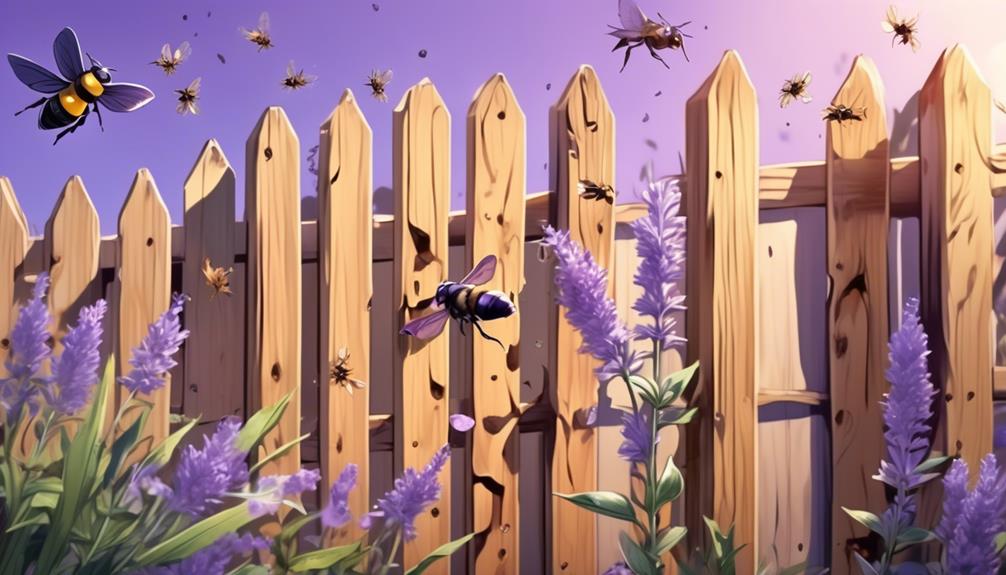Battle carpenter bees naturally with our eco-friendly solutions that protect both your home and the environment, discover more today!

How to Deter Carpenter Bees Naturally
Ever had to deal with the incessant buzzing of carpenter bees around your home? You're not alone. These creatures, though beneficial to the ecosystem, can become a real nuisance when they start burrowing into your wooden structures.
There are natural ways to deter these buzzing critters without resorting to harmful chemicals. You might wonder how you could possibly keep them at bay without causing harm to them or your environment.
Let's explore these eco-friendly solutions together, as you might find that the answer lies closer than you think.
Key Takeaways
- Citrus fruits like oranges, lemons, and grapefruits, as well as their peels, can be effective deterrents for carpenter bees.
- Almond oil and almond essence can be applied to surfaces to repel carpenter bees.
- Essential oils like tea tree, lavender, and citronella are also effective natural repellents for carpenter bees.
- Regular maintenance, such as sealing, staining, or painting wooden structures, checking for signs of carpenter bee damage, and removing old or decaying wood, can help prevent infestations.
Understanding Carpenter Bees

Before you can effectively deter carpenter bees, it's crucial to understand these unique creatures and their behaviors. Unlike their honeybee cousins, carpenter bees are solitary insects. They aren't part of a colony, and they don't produce honey or beeswax. Instead, they're named for their habit of boring into wood to create nests.
You've likely seen their handiwork, holes about half an inch in diameter, often on the underside of wooden structures. Inside these tunnels, female carpenter bees lay their eggs, leaving a supply of pollen for their offspring to feed on when they hatch. It's the female bees you'll often see, hovering near these nests, as they're tasked with protecting the eggs.
Carpenter bees are also unique in their appearance. They're larger than most bees, with shiny, hairless abdomens. They're often mistaken for bumblebees, but the latter have hairy abdomens and are social insects. It's important to note that while male carpenter bees can be aggressive, they're harmless, as they lack stingers. Females, while equipped with stingers, rarely sting unless provoked. This understanding can help you develop a more effective, and non-harmful, deterrent strategy.
Natural Repellents for Carpenter Bees

Armed with this knowledge of carpenter bees' habits and characteristics, you're better equipped to employ natural repellents that can deter these solitary insects without causing them harm.
Natural repellents come in a variety of forms, but the most effective ones are those that exploit the carpenter bees' natural aversions.
Citrus is a particularly potent deterrent. The strong scent of citrus fruits like oranges, lemons, and grapefruits is unappealing to carpenter bees. You can create a homemade repellent by boiling peels from these fruits and spraying the cooled solution on areas where you've seen carpenter bee activity.
Almond oil and almond essence also act as natural repellents. Carpenter bees dislike the smell of almonds, and these substances can effectively keep the bees at bay. Simply apply the oil or essence to surfaces where the bees are likely to nest.
Lastly, consider using essential oils such as tea tree, lavender, or citronella. These oils not only deter carpenter bees but also other insects. Apply the oil to a cotton ball and place it in areas where the bees frequent. Remember, the key here is application frequency as these natural solutions tend to evaporate faster than commercial ones.
DIY Bee Deterrent Solutions

While you can use store-bought repellents, it's quite straightforward and cost-effective to whip up your own DIY carpenter bee deterrent solutions at home, harnessing the power of ingredients like citrus peels, almond oil and essential oils.
Citrus peels contain d-limonene, a compound that's toxic to bees but safe for humans and pets. To use, boil peels from various citrus fruits in water, strain the liquid, and spray it where bees congregate.
Almond oil, on the other hand, is a potent deterrent due to its benzaldehyde content. Just a few drops applied to wood surfaces can help keep the pests at bay.
Essential oils, such as lavender, peppermint, and citronella, are also effective. These oils disrupt the bees' olfactory senses, making it difficult for them to locate their nests. A blend of these oils sprayed around their preferred nesting areas can significantly reduce their presence.
It's important to note, however, that these solutions deter, but don't kill, bees. Regular application is necessary for sustained results. Additionally, consider pairing these methods with physical deterrents like steel wool or caulking to seal off potential nesting sites.
Plant Choices to Discourage Bees

You can also opt to cultivate certain plants in your garden that naturally repel carpenter bees, effectively deterring these wood-boring pests from setting up home in your property. One such plant is the Citronella. Its strong scent, while pleasant to humans, can be overwhelming to carpenter bees and can help keep them at bay.
Marigolds are another good choice. They produce a scent that bees find unattractive, thus making your garden less appealing to them.
Furthermore, you can consider incorporating plants that attract bee predators. For instance, the Fennel plant attracts wasps, a known predator of carpenter bees. By having these plants in your garden, you're not only deterring carpenter bees, but you're also promoting a more balanced ecosystem.
However, it's crucial to remember that not all bees are harmful. Some bees, like honeybees and bumblebees, play a vital role in pollination. Therefore, you should aim to discourage only the destructive carpenter bees without harming beneficial bee species.
To do this, you'll need to carefully select and position your plants, ensuring you create a hostile environment for carpenter bees while still accommodating beneficial ones.
Regular Maintenance to Prevent Infestation

In addition to strategically selecting your plants, regular upkeep of your property plays a paramount role in preventing carpenter bee infestations. These bees are attracted to untreated, weathered wood, so ensure that you're maintaining all wooden structures regularly. Sealing, staining, or painting wooden surfaces can discourage carpenter bees, as they prefer bare wood to nest in.
Your attentiveness to the condition of your outdoor wooden items, such as fences, decks, and garden furniture, can't be overstated. Regularly check for signs of damage or wear and tear. If you notice small, round holes in wood or a sawdust-like substance nearby, it's likely you've got a carpenter bee problem.
Another crucial aspect of prevention is removing old or decaying wood from your property. Carpenter bees are drawn to such materials for nesting. By promptly removing these potential homes, you greatly reduce the chance of an infestation.
Lastly, consider the placement of your outdoor lights. Bees are attracted to light, so it's beneficial to keep lighting away from areas where they might nest. Regular maintenance and attention to these details can help you deter carpenter bees naturally, protecting your property from potential damage.
Conclusion
In conclusion, understanding carpenter bees is key to naturally deterring them.
Natural repellents, DIY solutions, and specific plant choices can all discourage their presence.
Regular maintenance is vital in preventing an infestation.
Remember, it's not about harming these vital pollinators, but about coexisting without letting them damage your property.
By implementing these strategies, you'll create a less appealing environment for carpenter bees, encouraging them to find somewhere else to make their home.



